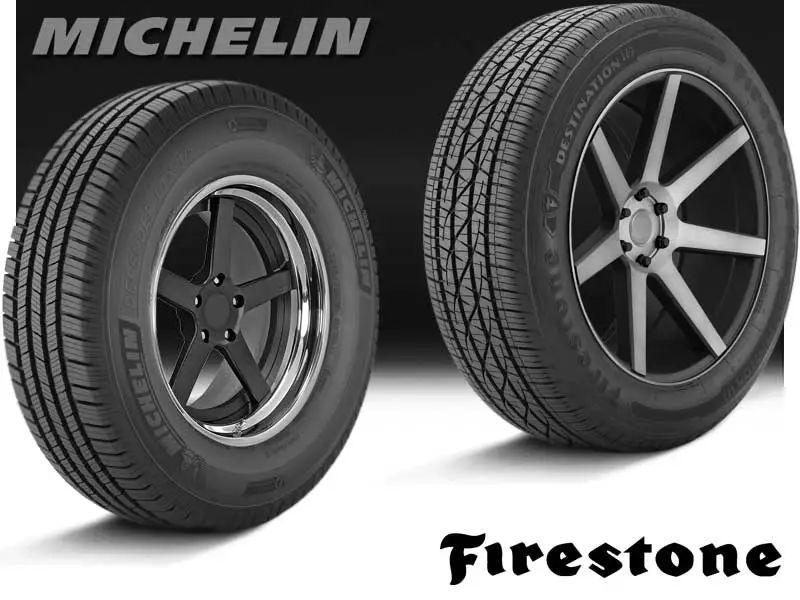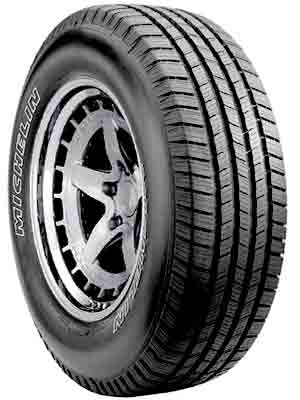Ever since Bridgestone took over Firestone, they have gotten into a good shape. But is the new Destination LE3 better here in comparison?
The Firestone Destination LE3 is an update to it’s LE2 variant, which didn’t provide enough wet traction, so with the newer tire, the company improved that, focusing on the hydroplaning for the most part (that’s why they introduced Hydro Grip Technology in this tire).

Let’s check it out, and see if it’s better than the Michelin Defender, starting things off with their designs.
Table of Contents
Tread Pattern Differences:
Firestone Destination LE3

Michelin Defender LTX MS

There are some key difference in both tires (that you can not miss), and to understand that we have to dig deep in to their pattern.
The Firestone Destination LE3 seems very complicated at first. But the tread can be easily understood by considering the following.
The central “S” shaped block which are surrounded by “F” shaped ones (if you can picture it, make abbreviation for Fire Stone).

All these blocks have chamfered edges (deformed edges curving inwards) and notches (which give them alphabetical shapes).
They are also seen with “M” shaped siping, which goes all the way deep, down to the base.
On the other hand, the Michelin Defender LTX M/S features a stable design of independent blocks which are separated by prominent lateral grooves.
All blocks in the middle vary in width but other than that, they all look same and have similar features.

All these blocks are also equipped with M shaped siping, and they are full depth as well. They are also more in no. as well compared to Destination LE3.
Furthermore, all blocks have offset edges and because of this they also make zig-zag lateral grooves between these blocks.
These grooves connect the wider circumferential ones as shown below.

So a total of 4 longitudinal channels are made, where all of them have similar width to them.
These provide a clear path for water (mostly) to pass through, preventing hydroplaning.

If we move towards the shoulders, both tires show up with a very similar design.
On the Firestone Destination LE3, the shoulder blocks don’t change shapes and stay similar throughout.

Here all of them have connector in between which restrict the movement, and the same time they are further divided by a longitudinal slit which makes another block with notches (facing inwards).
Furthermore, squiggly siping is seen here, which towards the outer edges deepen a little bit.
If we look at the Michelin Defender LTX M/S on the other hand, all shoulder blocks wary in width a lot.

Some get too small and get a single sipe while others are wide enough to carry as much as 3 of those.
They have a same pattern seen everywhere but, due to the size of the blocks here they are elongated a little bit.
Other design specs of these tires.
| Defender | Destination | |
| Tread Depth (avg) | 12/32″ | 10/32″ |
| Weight (avg) | 38.8 lbs | 29.7 lbs |
| Width (avg) | 10.3″ | 9.8″ |
| Sizes | 15 to 22″ | 15 to 22″ |
So the average tread depth, width as well as weight is seen more on Defender.
On Road Traction:
Both tires show amazing performance on road, but out of them, the Firestone LE3 showed better dry grip, and handling.
The tire offers firm blocks with champfered edges which while braking don’t exert force on others (because of the curve in their shapes).
So all blocks are completely independent to move, resulting in shorter braking distances.
In case of handling, where the tire’s shoulder come in to play, Firestone incorporated another rib alongside of shoulders.

These ribs (highlighted) make longitudinal slits and at the same time have lateral incisions to them, so the blocks are able to cover both momentum angles.
On corners, these ribs provide more contact with the road and at the same time allow blocks to move separately, enhancing friction with the asphalt.
It’s curved grooves besides joining other circumferential ones, interconnect siping and notches.
So the blocks get divided and gets more biting edges which aids the tire’s grip.
But still the tire is not able to outperform the Michelin Defender, on wet traction, as it simply offers more siping in comparison.
And with overall softer compound (in comparison), these sipes are more flexible to create vacuum, sucking water very efficiently (and spraying it out as the tire rolls over).
The tire also showed better hydroplaning on straight road (while on curves both tires have similar float speeds, with the help of LE3’s Hydro-Grip tech).
Hydroplaning is mostly associated with channels, and Defender with more tread depth (2/32″ more on average) allow more volume of water to pass through.
The tire is also wider of the two and has wider channels which also aids it further.
Noise, Comfort, & Fuel Efficiency:
The Firestone Destination because of it’s whisper grooves technology, is quieter of the two.
Most of the noise comes from the shoulder blocks, so LE3 with it’s connectors between these blocks don’t allow the sound wave to amplify.
Michelin Defender on the other side, although offers you with variable pitch technology with varying width shoulder blocks, it shows more on road noise in comparison.
So does that mean this tire is less comfortable?
Well, no, although every one has a slightly different definition of comfort, but we believe, it has little to do with noise levels and more to do with a overall feel of the ride.
Michelin Defender basically provides better cushioning to the impacts. The tire is softer of the two and it’s tread allows it to distribute the impacts/bumps uniformly.
But the more firmer ride on Firestone LE3 also renders these tires fuel efficient in comparison.
It’s harder compound combined with lesser weight (on average) provides less rolling resistance, so besides getting a cheaper tire, you also get to save more on fuel money, in the long run.
But how long would these tires last?
Durability and Tread Life:
Both tires have a same inner construction of 2 ply polyester with 2 steel belts and a single layer of polyamide/nylon.
So although both tires are pretty durable having same speed ratings up to H, the Michelin Defender still shows better longevity.
Although the softer rubber of Michelin Defender would wear faster in comparison, but with more tread depth, the tire would still take a little longer to completely wear, compared to Destination LE3.
Furthermore, with Michelin technology like the Max Touch, which helps the tire to wear uniformly across its tread. And it’s EverTread compound is basically a hybrid of tread and polymers, resins and silica, so the tire at the same time also shows better protection against chips and tears.
That’s why, Michelin also offers better, 70k miles warranty (for P metric and 50k for LT), where the Firestone offers 50k on all.
Traction Off Road:
Both can handle only a little bit of off road, and you can’t expect all-terrain tire’s performance out of them…
Having said that, the Michelin Defender shows better efficacy here overall.
The tire simply features wider grooves that can take a little bit of off-road.
The Firestone Destination LE3 on the other side, although provide you with notches/biting edges everywhere, the less wider grooves combined with less tread width and depth, does not allow the tire to self clean it’s tread efficiently (in comparison).
Even in snow, where the less width of the tire is better (because skinnier tire easily cuts trhough), it still is not able to outperform Defender.
Michelin LTX MS simply has more siping to it, and it’s softer rubber is less prone to getting stiffen up with lower temperatures of snowy terrains.
What’s the verdict?
Michelin Defender is pricey of the two, but it really justifies it’s price tag with better wet traction and comfort, combined with durability.
Firestone Destination LE3 on the other hand, although saves you some bucks, as it costs less and you spent less on fuel (in the long run), you have to compromise a little, when it comes to wet traction, and overall comfort (slightly)


